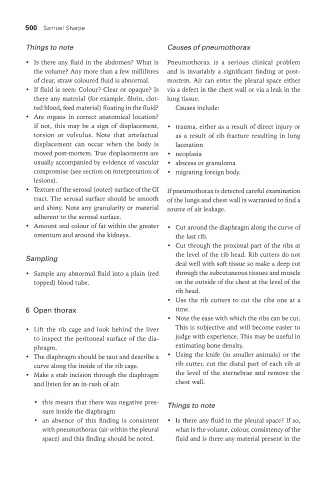Page 563 - The Veterinary Laboratory and Field Manual 3rd Edition
P. 563
500 Samuel Sharpe
Things to note Causes of pneumothorax
• Is there any fluid in the abdomen? What is Pneumothorax is a serious clinical problem
the volume? Any more than a few millilitres and is invariably a significant finding at post-
of clear, straw coloured fluid is abnormal. mortem. Air can enter the pleural space either
• If fluid is seen: Colour? Clear or opaque? Is via a defect in the chest wall or via a leak in the
there any material (for example, fibrin, clot- lung tissue.
ted blood, feed material) floating in the fluid? Causes include:
• Are organs in correct anatomical location?
If not, this may be a sign of displacement, • trauma, either as a result of direct injury or
torsion or volvulus. Note that artefactual as a result of rib fracture resulting in lung
displacement can occur when the body is laceration
moved post-mortem. True displacements are • neoplasia
usually accompanied by evidence of vascular • abscess or granuloma
compromise (see section on interpretation of • migrating foreign body.
lesions).
• Texture of the serosal (outer) surface of the GI If pneumothorax is detected careful examination
tract. The serosal surface should be smooth of the lungs and chest wall is warranted to find a
and shiny. Note any granularity or material source of air leakage.
adherent to the serosal surface.
• Amount and colour of fat within the greater • Cut around the diaphragm along the curve of
omentum and around the kidneys. the last rib.
• Cut through the proximal part of the ribs at
the level of the rib head. Rib cutters do not
Sampling
deal well with soft tissue so make a deep cut
• Sample any abnormal fluid into a plain (red through the subcutaneous tissues and muscle
topped) blood tube. on the outside of the chest at the level of the
rib head.
• Use the rib cutters to cut the ribs one at a
6 open thorax time.
• Note the ease with which the ribs can be cut.
• Lift the rib cage and look behind the liver This is subjective and will become easier to
to inspect the peritoneal surface of the dia- judge with experience. This may be useful in
phragm. estimating bone density.
• The diaphragm should be taut and describe a • Using the knife (in smaller animals) or the
curve along the inside of the rib cage. rib cutter, cut the distal part of each rib at
• Make a stab incision through the diaphragm the level of the sternebrae and remove the
and listen for an in-rush of air: chest wall.
• this means that there was negative pres- Things to note
sure inside the diaphragm
• an absence of this finding is consistent • Is there any fluid in the pleural space? If so,
with pneumothorax (air within the pleural what is the volume, colour, consistency of the
space) and this finding should be noted. fluid and is there any material present in the
Vet Lab.indb 500 26/03/2019 10:26

